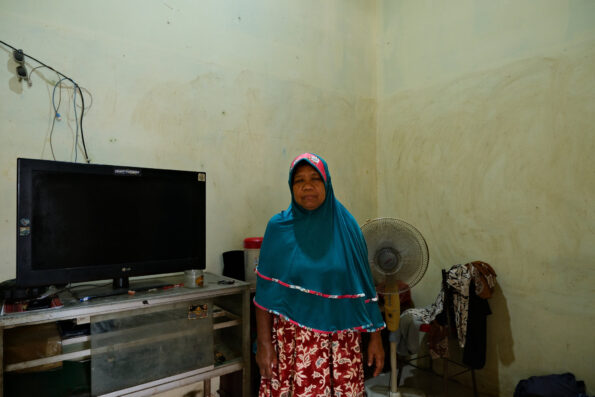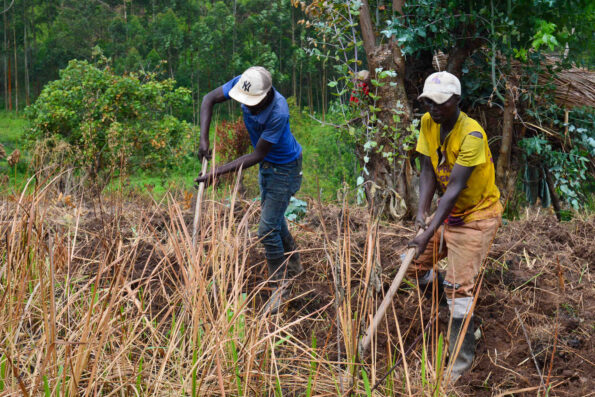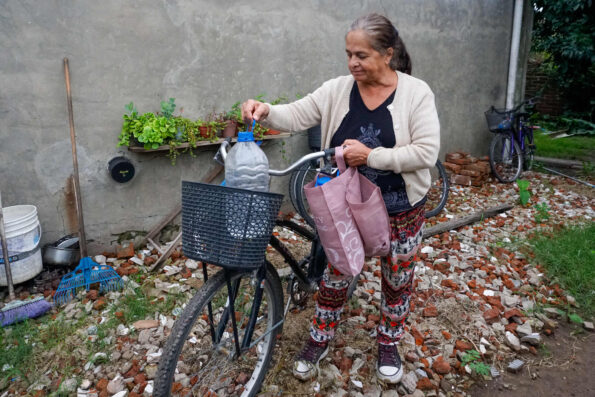
Lucila Pellettieri, GPJ Argentina
A lagoon where trash is dumped in Villa Inflamable, a neighborhood on the polluted Matanza-Riachuelo River in Buenos Aires, Argentina.
BUENOS AIRES PROVINCE, ARGENTINA — An acrid smell permeates Villa Inflamable, the shantytown just outside of the far southeastern side of Argentina’s capital, Buenos Aires. Through litter-strewn streets, an industrial truck advances toward a fluorescent lagoon, where glass bottles bob instead of fish.
After a few minutes, the truck returns empty. This sequence is repeated throughout the day, with the dumped debris eventually blending into a mélange of filth that is the Matanza-Riachuelo. The river, approximately 70 kilometers (43 miles) long, is one of the world’s most contaminated waterways. Thousands of factories line its shores, with many using river water to process chemicals and pharmaceuticals. The river receives slaughterhouse and tannery wastes and the untreated excrement of many of the 5 million people who live nearby, 55 percent of whom lack sewage facilities.
Argentina’s Supreme Court in 2008 ordered the government to clean up the area, prevent further ecological degradation and improve the living conditions of its residents, many of whom have become ill. Children tested here show stratospheric levels of lead poisoning. Respiratory diseases, rashes and diarrhea are common. (Read our previous coverage here.)
INSIDE THE STORY: A reporter was reluctant to write a second time about health problems linked to pollution in the Matanza-Riachuelo river basin in Buenos Aires, because the story wasn’t “new.” But knowing that in a year’s time nothing had been done to address the issue, and seeing children in danger, made her realize it was worth writing about the same thing twice. Read the blog.
More than eight years later, the authority tasked with restoring the area, the Autoridad de la Cuenca Matanza-Riachuelo (ACUMAR), has spent $5.2 billion and completed only about 20 percent of the cleanup, according to the latest figures the agency presented in November 2016. Of the 1,397 businesses ACUMAR considers “contaminants,” it reported that 1,178 had presented plans to convert to more ecologically sound processes and 412 had completed pollution-reducing conversions.
ACUMAR also is years behind on its commitment to relocate 17,771 families, having relocated only 14 percent, according to a report by the Auditoría General de la Nación, a body that assists Congress in controlling government accounts.
“Since 2010, they’ve told us that they’ll relocate us and nothing happens,” says Claudia Espinola, a member of one of the 1,500 Villa Inflamable families who have been waiting for years for the promised cleanup and relocation.
Since residents don’t know if they’re going to be relocated to another neighborhood, they say they can’t invest to improve their homes out of fear of losing money if the government finally moves them, Espinola says.
The government trucks in water in 10-liter barrels for residents, she says, but “it’s not enough for everything. We end up washing dishes and bathing in contaminated water.” Some residents, she says, can’t carry the giant bottles and “they also end up drinking contaminated water.”
So little has been done to understand resident needs and so much of what has been promised has failed to come through that many families no longer trust that ACUMAR wants to do right by them, says Guadalupe Falbo, an attorney with the Asociación Civil por la Igualdad y la Justicia (ACIJ), an organization that defends the rights of disadvantaged groups, says.
“There was no survey done on who wants to go, or who should have priority for health reasons,” Falbo says. “The children with lead are only screened to see if they still have lead, but they don’t get any treatment. That’s why many of the parents don’t want to take them to the hospital anymore.”
It’s gotten so bad, “residents often don’t want to go to the meetings because they consider them a joke,” Falbo says.
Without community information, a decision was made that Villa Inflamable families would be resettled in Alianza, a neighborhood between Villa Tranquila and Isla Maciel.



So while Villa Inflamable residents like 66-year-old María del Pilar Sáenz, who has respiratory problems, says “living here is a mortal danger to our health,” some of the residents like Espinola fear the move as well. “Nobody can assure us that it is not contaminated there,” explains Espinola. Additionally, she says, it is a place that supports a rival soccer team and violence has broken out between the two areas. “That they take us there is like they take us to the mouth of a wolf,” she says. “We are not guaranteed any security.”
Residents in 2016 published a list of the six most urgent problems to solve in the neighborhood. The main actions include: to provide comprehensive medical treatment for children who suffer lead contamination and to provide avenues to involve residents in relocation decisions.
They also want working sewage and drinking water systems, the cleanup of lagoons and depressions that neighbors use as makeshift sewers and fill with garbage, street improvements and better street lighting.
Residents and environmental organizations expected that a change in government in which the political coalition Cambiemos swept into power in late 2015 in all three jurisdictions tasked with the cleanup would help solve political problems that slowed progress on cleaning and relocation. A year later, that has not been the case.
“We’d hoped that when the political parties of the three jurisdictions coincided – the nation, the province and the city of Buenos Aires – they’d stop passing the buck, but they keep doing it,” says Santiago Cané, an attorney with Fundación Ambiente y Recursos Naturales.
“We ask that a risk map be drawn up and health problems be linked to the sources of pollution,” Cané says. “The map will begin to indicate the most urgent actions and begin to hold officials and companies accountable.”
ACUMAR announced in February that it is joining together with Agua y Saneamientos Argentinos, the Argentine company that provides public water services and sewage collection for the capital city, and 14 parties in the Buenos Aires suburban area to accelerate sewer system work so it can be in place by 2021. The World Bank has committed $840 million to the $1 billion project, which ACUMAR says would incorporate 1.5 million residents into the sewer network and improve the sanitary system for more than 4 million.
ACUMAR also announced March 20 that it delivered 40 garbage trucks to the municipalities in the basin area to properly dispose of trash and other debris that now end up in Riachuelo estuaries.
What is most worrisome is the lack of a comprehensive approach to relocating residents, says Bárbara Rossen, deputy minister of the Subsecretaria de Derechos Urbanos, Espacio Público y Medio Ambiente de la Defensoría del Pueblo for the Buenos Aires city government. The ministry is tasked with defending urban and public spaces, and the environment.
“They relocate them without taking into account if the new neighborhood has a new school, health clinic or businesses. So then if you put up a house, but you didn’t improve the quality of life of these people, so then you’re not meeting the objective,” she says.
A lagoon where trash is dumped in Villa Inflamable, a neighborhood on the polluted Matanza-Riachuelo River in Buenos Aires, Argentina.
Lourdes Medrano, GPJ, translated this article from Spanish.







